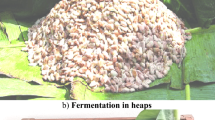Abstract
Caperberries (0.7–1.9 cm diameter), collected in June 1996, were pickled for 1 month in 5% and 10% brine. Some physical, chemical and microbiological analyses were made during their fermentation and storage. While lactic acid bacteria (LAB) increased during fermentation in 5% brine, they did not increase after 15 days in 10% brine. In some cases, total bacterial (TB) growth decreased. In both brines, yeasts/moulds and coliforms (except for 5% brine on day 15) were not present after 15 and 20 days, respectively. For both caper species, the most suitable salt concentration, for LAB activity was 5–10% NaCl, and the best length of fermentation with respect to product colour, flavour, acidity, pH and LAB activity in brine was 20–25 days. The texture was maintained well during storage. Acidity and pH were markedly affected by the concentration of brine. The quality of all samples was maintained with a 15% concentration of old or fresh brine during storage. The colour of the samples, especially those of C. ovata, stored with old brine was darker that of fresh berries. As no "off" flavour was observed, it was concluded that pickled caper berries can be stored in fresh brine with a 15% NaCl concentration.
Similar content being viewed by others
Author information
Authors and Affiliations
Additional information
Received: 26 June 1998
Rights and permissions
About this article
Cite this article
Özcan, M. Pickling and storage of caperberries (Capparis spp.). Z Lebensm Unters Forsch 208, 379–382 (1999). https://doi.org/10.1007/s002170050433
Issue Date:
DOI: https://doi.org/10.1007/s002170050433




